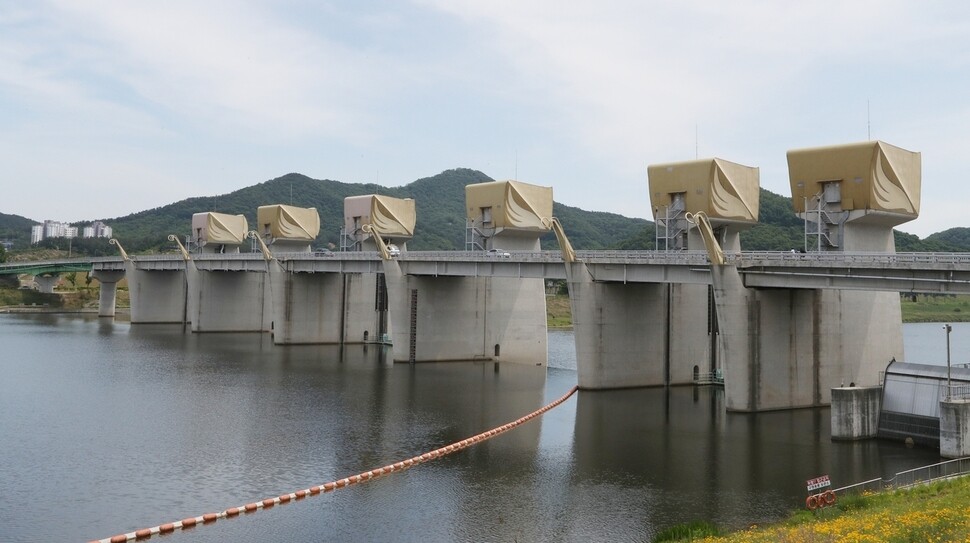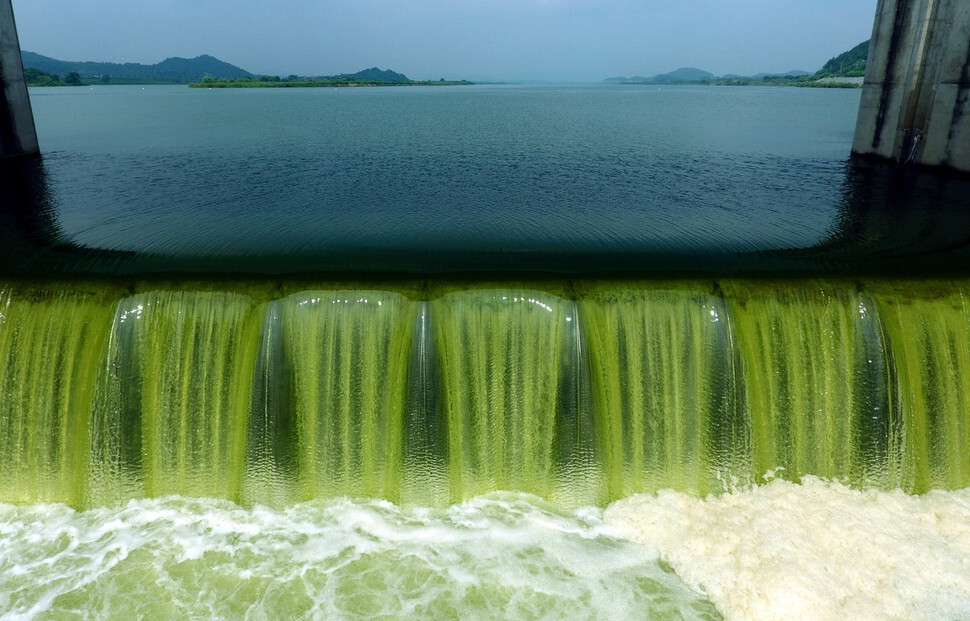hankyoreh
Links to other country sites 다른 나라 사이트 링크
A “revolution in water management” as Four Major Rivers to flow again

The choked waterways of the Four Major Rivers Project are set to open again.
President Moon Jae-in ordered the permanent opening in June of six of the 16 weirs in the project that are seen as carrying a high risk of green algae, the Blue House said on May 22. The opening of the weirs comes around five years after the Lee Myung-bak administration spent 22 trillion won (US$19.7 billion) in taxpayer money to build them on the four rivers.
Moon also ordered the integration of water management duties - previously split between the Ministry of Land, Infrastructure and Transport (MOLIT) and Ministry of Environment (MOE) - under MOE and a policy audit on the entire decision-making and execution process for the Four Major Rivers Project. Academic observers and civic groups are calling the measures the first step in a paradigm shift from development and engineering to management and preservation as a focus in national land usage policy.
“After hearing reports on various data and policy directions in connection with the four rivers last week, President Moon ordered the immediate opening of sluice gates for six weirs on the Nakdong, Geum, and Yeongsan Rivers,” Blue House Senior Secretary to the President for Social Affairs Kim Soo-hyun said in a May 22 briefing at the Blue House.
“Related details have been communicated to the relevant agencies, and preparations for follow-up actions have begun,” Kim said.
The weirs that are to be permanently opened are located at Goryeong, Dalseong, Changnyeong, and Haman in the Nakdong River, Gongju in the Geum River, and Juksan in the Yeongsan River. Decisions regarding the degree and methods of opening for the other ten weirs, including those at Ipo, Gangcheon, and Yeoju in the Han River, are to be made on a stepwise basis after a close examination of ecosystem changes, water source availability, weir safety, and other issues.
“For the final measures on all 16 weirs, a joint private-government investigation and assessment team for the four rivers is going to be put together to conduct a year-long close observation of ecosystem changes and water quality and volume conditions before a final decision is made,” Kim said.

As scholars and environmental groups have requested, the Blue House plans to proceed cautiously with the complete removal of the weirs to restore the rivers to their natural state.
“We‘ll need to attempt natural restoration for some of the weirs, but there will be others where we’ll have to keep them in place for environment and water resource purposes,” Kim explained.
“The final decision will need to be based on a thoroughly scientific determination following the basic principles for an environmental impact assessment,” he added.
Another notable development is the decision to integrate water management duties under MOE instead of keeping them divided between MOE and MOLIT.
“In terms of water management duties, MOLIT manages water volume while MOE manages water quality. But as we’re seeing with the four rivers, too much of a priority on water volume has resulted in controls and balance failing to function, despite clear concerns about deteriorating water quality,” Kim said.
Kim also said MOLIT’s water resource bureau would be transferred to MOE, while the Korea Water Resource Corporation (K-Water) would move from MOLIT to become an agency under MOE. The remarks mean the K-Water relocation will also be included in a provisional government reorganization plan to be released later this month.
Kim also unveiled plans for a Board of Audit and Inspection (BAI) audit of the Four Major Rivers Project policy making and execution process.
“The focus won‘t be on finding illegal actions by individual people, but on learning the necessary lessons in terms of coordination, consistency, and balancing in policy decision-making,” Kim said.
At the same time, he also warned that “corresponding actions [including legal measures] will be unavoidable if clear violations of the law are discovered in the audit process.” The message means the audit could turn into an investigation of the Lee administration that pursued the Four Major Rivers Project, depending on how the results come out.
Experts welcomed the administration’s move.
“This is the closest thing to a revolution in water management,” said Park Chang-keun, a civil engineering professor at the Catholic University of Korea.
“This is going to drive a wedge in the agencies’ practices of pursuing projects for projects’ sake, while signaling a policy paradigm shift from obtaining resources through development to managing and preserving resources,” a hopeful Park predicted.
Park Jae-hyun, an Inje University civil and urban engineering professor who accompanied Moon on a visit last year to a Nakdong River estuary embankment, said, “More than just opening the weirs, we urgently need to ensure consistency in water resource management by submitting the general long-term water resource plan and river and stream framework plan to full-scale reexamination.”
Lee Myung-bak (in office 2008-13) responded the same day with a position statement in the name of his secretariat.
“The Four Major Rivers Project was carried out to resurrect abandoned rivers and ensure water resources in the event of natural disaster resulting from climate change,” the statement read.
“Instead of digging to find issues with a policy effort from two administrations ago, for which audits, trials, and assessments have already been completed, the administration should complete follow-up efforts for the four rivers.”
By Lee Se-young, staff reporter
Please direct questions or comments to [english@hani.co.kr]

Editorial・opinion
![[Column] Season 2 of special prosecutor probe may be coming to Korea soon [Column] Season 2 of special prosecutor probe may be coming to Korea soon](https://flexible.img.hani.co.kr/flexible/normal/500/300/imgdb/original/2024/0426/3317141030699447.jpg) [Column] Season 2 of special prosecutor probe may be coming to Korea soon
[Column] Season 2 of special prosecutor probe may be coming to Korea soon![[Column] Park Geun-hye déjà vu in Yoon Suk-yeol [Column] Park Geun-hye déjà vu in Yoon Suk-yeol](https://flexible.img.hani.co.kr/flexible/normal/500/300/imgdb/original/2024/0424/651713945113788.jpg) [Column] Park Geun-hye déjà vu in Yoon Suk-yeol
[Column] Park Geun-hye déjà vu in Yoon Suk-yeol- [Editorial] New weight of N. Korea’s nuclear threats makes dialogue all the more urgent
- [Guest essay] The real reason Korea’s new right wants to dub Rhee a founding father
- [Column] ‘Choson’: Is it time we start referring to N. Korea in its own terms?
- [Editorial] Japan’s rewriting of history with Korea has gone too far
- [Column] The president’s questionable capacity for dialogue
- [Column] Are chaebol firms just pizza pies for families to divvy up as they please?
- [Column] Has Korea, too, crossed the Rubicon on China?
- [Correspondent’s column] In Japan’s alliance with US, echoes of its past alliances with UK
Most viewed articles
- 1[Column] Season 2 of special prosecutor probe may be coming to Korea soon
- 2‘We must say no’: Seoul defense chief on Korean, USFK involvement in hypothetical Taiwan crisis
- 3Is N. Korea threatening to test nukes in response to possible new US-led sanctions body?
- 4No good, very bad game for Korea puts it out of Olympics for first time since 1988
- 5Is Japan about to snatch control of Line messenger from Korea’s Naver?
- 6Division commander ordered troops to enter raging flood waters before Marine died, survivor says
- 7Korea’s 1.3% growth in Q1 signals ‘textbook’ return to growth, says government
- 8N. Korean delegation’s trip to Iran shows how Pyongyang is leveraging ties with Moscow
- 9[Editorial] Korea’s surprise Q1 growth requires objective assessment, not blind fanfare
- 10[Editorial] Government needs to stop impeding Sewol mourning